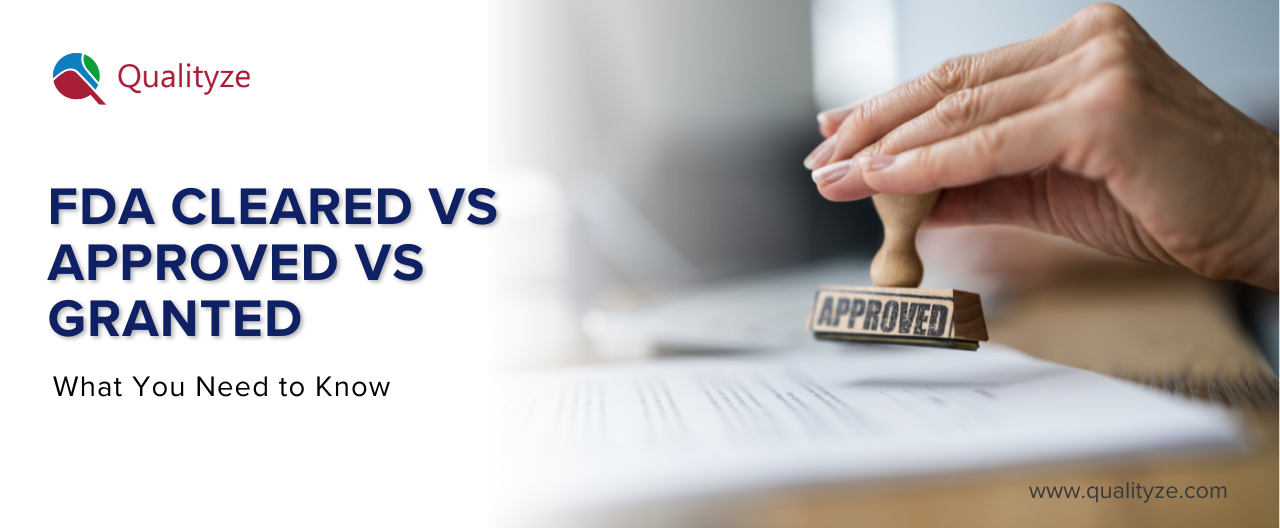Calculate your potential savings with our ROI Calculator
ROI CalculatorCalculate your potential savings with our ROI Calculator
ROI Calculator1 What is FDA-cleared, Approved, and Granted
2 Difference between FDA Cleared, Approved, and Granted
3 Why Is FDA Approval Important for Medical Devices?
4 How to Determine If Your Product Is FDA Cleared, Approved, or Granted
5 Importance of FDA Designations: Cleared, Approved, and Granted
6 Top Facts About FDA Clearance, Approval, and Grant Processes
7 Conclusion

Have you ever wondered about the differences between “FDA cleared," “FDA approved,” and “FDA granted” when it comes to medical products? Understanding these distinctions is crucial whether you are a patient, a healthcare professional, or a manufacturer navigating the complex regulatory landscape.
The U.S. Food and Drug Administration (FDA) employs these designations to regulate medical devices, drugs, and other health-related products, ensuring public health and safety. Each term reflects a specific regulatory pathway and a different level of FDA scrutiny.
Navigating these pathways demands meticulous documentation, robust quality management, and adherence to strict regulatory guidelines. A comprehensive Enterprise Quality Management System (EQMS) like Qualityze EQMS plays a crucial role in this process. Qualityze EQMS helps organizations streamline their quality management processes, ensuring compliance with FDA regulations through features such as document control, audit management, corrective and preventive actions (CAPA), and training management.
The FDA employs various regulatory pathways to evaluate medical devices based on their risk levels and intended uses:
| Feature | FDA Cleared (510(k) Premarket Notification) | FDA Approved (PMA for devices, NDA for drugs) | FDA Granted (De Novo Classification) |
| Regulatory Pathway | Premarket Notification (510(k)) | Premarket Approval (PMA) for devices, New Drug Application (NDA) for drugs | De Novo Classification Request |
| Device Risk Class | Primarily Class I (low risk) and Class II (moderate risk), when a predicate device exists. | Class III (high risk), typically devices that support or sustain human life, or present a potential, unreasonable risk of illness or injury. | Novel Class I or Class II devices (low to moderate risk) for which no predicate device exists. |
| Basis of Review | Substantial equivalence to a legally marketed predicate device. Focus on "as safe and effective." | Comprehensive demonstration of safety and effectiveness through clinical trials and extensive data. | Establishes a new classification and regulatory controls (general and/or special controls) for novel low-to-moderate risk devices. |
| Evidence Required | Performance data, labeling, sometimes clinical data, demonstrating equivalence to a predicate. | Extensive non-clinical laboratory studies, animal studies, and human clinical trials. | Data demonstrating reasonable assurance of safety and effectiveness, often including bench testing and non-clinical data; clinical data may be needed. |
| Typical Products | Many common medical devices like surgical instruments, examination gloves, some diagnostic tools, basic imaging equipment, new versions of existing devices. | Implantable devices (pacemakers, artificial hips), life-sustaining devices (ventilators), new drugs, complex diagnostic tests. | Novel software as a medical device (SaMD), new types of wearable health trackers, innovative diagnostic platforms without a precedent. |
| Timeframe | Generally shorter, typically 90 days for review. | Significantly longer, often years, due to extensive data requirements and clinical trials. | Variable, but generally shorter than PMA, though longer than 510(k) if extensive new data is needed. |
FDA approval represents the pinnacle of regulatory achievement for high-risk medical devices and drugs. It ensures that products meet stringent safety and effectiveness standards before they reach patients. This rigorous process is vital for several reasons:
Knowing the correct FDA designation for a product requires careful investigation. Do not rely solely on marketing claims, as companies sometimes misrepresent these terms.
| Designation | Importance for Patients | Importance for Healthcare Professionals | Importance for Manufacturers |
| FDA Cleared | Indicates the device is safe and effective for its intended use, similar to existing options, offering a reliable choice. | Provides confidence in using devices with an established safety profile and comparable performance to market standards. | Allows faster market entry for devices that are variations of existing technology, reducing development and regulatory burden. |
| FDA Approved | Ensures the highest level of safety and effectiveness for high-risk products, vital for critical treatments and conditions. | Offers the strongest assurance of a product's efficacy and safety, enabling confident prescription and use in critical situations. | Grants access to the U.S. market for novel drugs and high-risk devices, validating extensive research and development. |
| FDA Granted | Introduces new, safe, and effective low-to-moderate-risk devices that address unmet needs or offer innovative solutions. | Provides access to new technologies that may improve patient care, even without a direct predicate device. | Establishes a new regulatory pathway for innovative devices, enabling market access for novel low-to-moderate risk products. |
| Fact | Insight |
| 1 | Over 80% of medical devices enter the market through the 510(k) process. |
| 2 | PMA is the most stringent FDA review process, often taking over 180 days. |
| 3 | De Novo pathway was established to accommodate novel devices without predicates. |
| 4 | FDA approval is mandatory for Class III devices before marketing. |
| 5 | The FDA provides databases to verify device approval statuses. |
Understanding the distinctions between FDA-cleared, Approved, and Granted is essential for medical device manufacturers, healthcare providers, and consumers. Each designation represents a different level of scrutiny and regulatory pathway, impacting how devices are brought to market and perceived in terms of safety and effectiveness.
Implementing robust quality management systems like Qualityze EQMS significantly aids in navigating these regulatory pathways. By ensuring comprehensive documentation, streamlined processes, and compliance with FDA standards, organizations can enhance their readiness for FDA submissions and inspections.